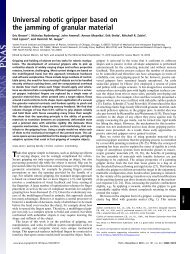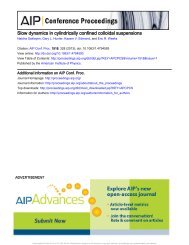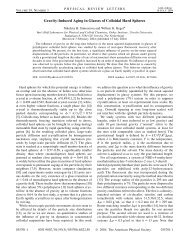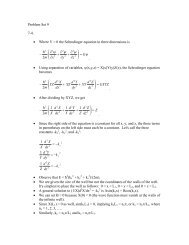Essay contest reveals misconceptions of high school ... - Genetics
Essay contest reveals misconceptions of high school ... - Genetics
Essay contest reveals misconceptions of high school ... - Genetics
Create successful ePaper yourself
Turn your PDF publications into a flip-book with our unique Google optimized e-Paper software.
Year<strong>Genetics</strong> Education 1159TABLE 2<strong>Essay</strong> <strong>contest</strong> questions in 2006 and 2007Question2006 Why is it important for everyone to know about genetics?2006 and 2007 If you could be a human genetics researcher, what would you study and why?2007 In what ways will knowledge <strong>of</strong> genetics and genomics make changes to healthand health care in the United States possible?Table 3 summarizes the number <strong>of</strong> essays submittedduring each year <strong>of</strong> the <strong>contest</strong>. The students who wrotethe top three essays for each question were declaredfirst, second, and third place winners through thejudging process described in methods. These studentswere awarded $350, $250, and $150, respectively. Themonetary awards were made possible by the sponsorship<strong>of</strong> Applied Biosystems (Foster City, CA). While manyessays demonstrated a clear understanding <strong>of</strong> geneticsand its implications, a significant number <strong>of</strong> contributedessays revealed firmly held misinformation and<strong>misconceptions</strong> by U.S. students in grades 9–12. Thisarticle examines those <strong>misconceptions</strong>, provides possibleexplanations for their origins, and suggests ways thatscientists, pr<strong>of</strong>essors, and teachers can collaborate toimprove genetics education at the K–12 level.METHODSJudging <strong>of</strong> essays: All aspects <strong>of</strong> the National DNADay <strong>Essay</strong> Contest were managed online from initialadvertisement to final judging. Information technologyspecialists from ASHG and the <strong>Genetics</strong> Society <strong>of</strong>America (GSA) were able to adapt existing societyresources to facilitate essay acceptance, cataloging, andscoring. Judges were recruited from the active membership<strong>of</strong> ASHG, GSA, and the National Society <strong>of</strong> <strong>Genetics</strong>Counselors (NSGC). Three groups <strong>of</strong> judges were utilized.Each year students were given a choice betweentwo essay questions. The questions from 2006 and 2007are <strong>high</strong>lighted in Table 2. The first group <strong>of</strong> judges readlarge groups <strong>of</strong> essays on either <strong>of</strong> the two essay topics,scanning these essays to ensure they fulfilled all criteriaand addressed all aspects <strong>of</strong> the judging criteria. Thecriteria were slightly different for each <strong>of</strong> the twoquestions and were all published online for all studentsand teachers. The scoring criteria for the 2007 questionsare documented in Table 4. <strong>Essay</strong>s not fulfilling thesecriteria after being reviewed by at least two judges wereremoved from more detailed consideration. The secondgroup <strong>of</strong> judges scored 10–15 essays in depth, providinga score (from 1 to 10) in each <strong>of</strong> the five categories.Each essay was scored by at least three independentjudges. Scores were tabulated and the 10 essays with the<strong>high</strong>est scores for each topic were named as finalists.The last set <strong>of</strong> judges reviewed and scored each <strong>of</strong> thefinalist essays with the <strong>high</strong>est-scoring essays beingchosen as winners. One hundred ten members <strong>of</strong> theASHG, GSA, or NSGC membership served as judgeseach year. The entire adjudication process is reviewed inFigure 1. This system allowed us to perform all judginganonymously and ensure that each essay was read andscored by multiple independent reviewers while simultaneouslyinvestigating each essay for scientific accuracy.Identification <strong>of</strong> <strong>misconceptions</strong>: All judges, alongwith scientists on ASHG staff, were asked to examineeach essay for <strong>misconceptions</strong> or incorrect statementsand forward this information along with their scores. All<strong>misconceptions</strong> were collected over 2 years from individualjudges but were placed into categories by twoindividual coders (K. R. Mills Shaw and K. Van Horne)on the basis <strong>of</strong> the genetic topic that the misconceptionaddressed (Table 5). These topics were generated denovo after reviewing all the <strong>misconceptions</strong> submittedfrom judges and after K. R. Mills Shaw and K. Van Horneadditionally independently evaluated 125 randomlyselected essays from each year (2006 and 2007). All<strong>misconceptions</strong> were then cataloged under these specifictopic areas to better characterize the areas where<strong>misconceptions</strong> are most common (seen in Table 6).Five hundred essays, or 20%, were randomly selected forthis level <strong>of</strong> systematic review. Specifically, every fourthessay was analyzed in detail. If, however, essays weredeemed completely unsatisfactory for review (e.g., tooshort, too poorly defined, too poorly written), the essaywas not included in the systematically reviewed sample<strong>of</strong> 500. A misconception/misunderstanding was identifiedas any clearly written statement that did notaccurately reflect the nature <strong>of</strong> genetic science, technology,or research as defined by K. R. Mills Shaw andJ. A. Boughman, both Ph.D. scientists with a backgroundin genetics. <strong>Essay</strong>s where language or communicationbarriers were obvious (due to vocabulary, grammatical,TABLE 3<strong>Essay</strong> <strong>contest</strong> participation in 2006 and 20072006 2007Total number <strong>of</strong> essays received 1519 927Number <strong>of</strong> states represented 27 42Number <strong>of</strong> teachers represented 165 387



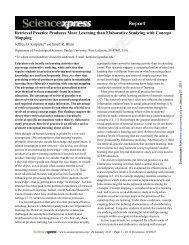
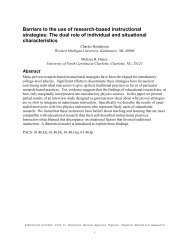
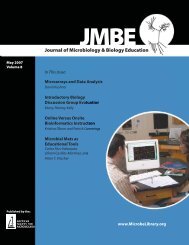
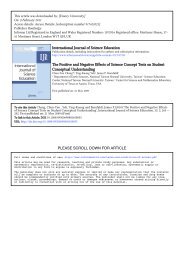
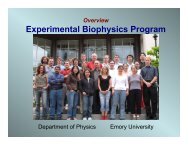
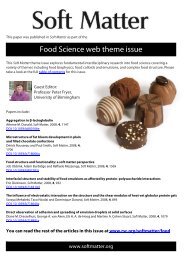

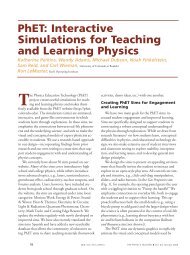
![view the Dish Show [PDF] - Department of Physics - Emory University](https://img.yumpu.com/45032745/1/190x146/view-the-dish-show-pdf-department-of-physics-emory-university.jpg?quality=85)

